Exploring Morocco
The Royal Cities of Marrakech, Rabat, Fès & the Atlas Mountains
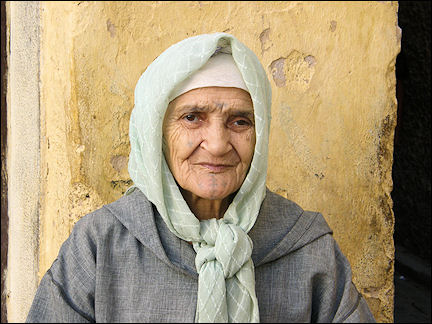
|
The trip starts in Marrakech with its souks and the lively market square Jemaa el-Fna, which at night changes into one big restaurant, then crosses the Atlas Mountains to Zagora, for a dromedary tour of the desert. After a visit to the kasbah of Aït ben Haddou it's on to Rabat with its impressive cemetary Cimetière Al Shouhada. The tour by train and van ends in Fès, with its famous tanneries in the alleys of the medina.
Travelogue: Jan Noot
Photos: Septima Bramer & Jan Noot
Marrakech
An old man with a straw hat takes a nap on his donkey cart
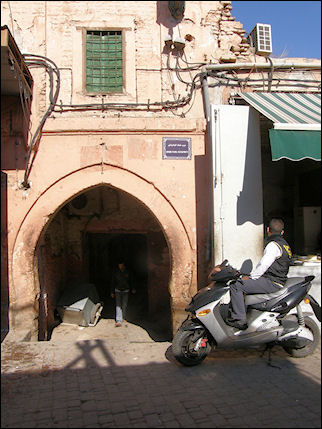
|
An old taxi takes us from the airport of Marrakech to the medina. We enjoy the heat and the total chaos on the road: mopeds, donkey carts, overloaded trucks and - closer to the city center - horse-drawn carriages with tourists.
We drive along olive orchards and pass the long, terra-cotta colored city walls. Along the side of the road grow orange trees, whose foliage is cut in cube shapes.
We are dropped at a dead end street: the hotel I booked via internet can only be reached on foot. Only after a lot of looking and asking we find our riad's large brown entrance door.
A black bird hops over wet stones on which the sun never shines. A skinny cat roams the alley. It smells here like a cat's litter box.
We ring the doorbell and a beaming Moroccan woman answers the door. We are in the right place. From the roof terrace, which has a diminutive swimming pool that actually looked bigger on the picture I saw on the internet, we have a view of yellow, pink and terra-cotta colored houses.
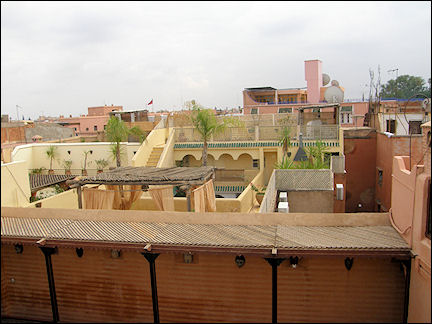
|
First we explore the city. We wander through "our" street, Fhal Zefriti, which has dozens of small stores. Colorful plastic bags, shawls and long dresses hang below a lean-to. Large burlap sacks filled to the brim with spices stand in front of a shelf. A woman with headscarf is making large thin pancakes on a hot metal plate.
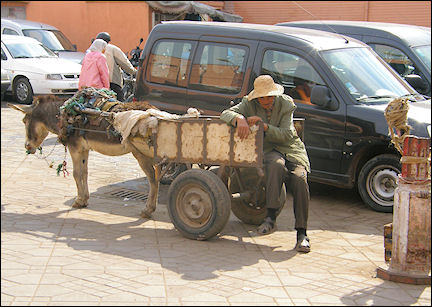
|
Rolls of chicken wire and trolleys stand in front of a hardware store and steel wheels and big chains hang from hooks. Next to those is a showcase with new cell phones. Men in long white or brown gowns with hoods walk by. An old man with a straw hat takes a nap in the back of his donkey cart.
Square Jemaa el-Fna in the daytime
Carpets, dentures, snake charmers and macaques
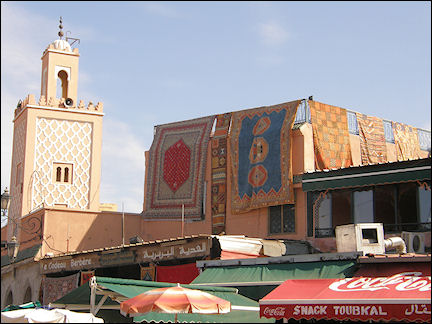
|
Around the corner is the vast square Jemaa el-Fna. Early in the morning the dirty cobblestones are hosed down. In some places there's a stench of rotting fruit and urine. There are several café-restaurants and hotels, each with their own Terrasse panoramique.
Large, rectangular carpets hang from railings on some roofs; they are advertised as Cadeau Berbère.

|
Shoeshiners sit in a line, waiting for customers. There are acrobats, who turn somersaults from a standing position or stand on each other's shoulders. Snakecharmers sit below large green umbrellas on carpets and play metal wind instruments. They sway their flutes from left to right in the faces of the spectacled cobras, which rise from shallow baskets.
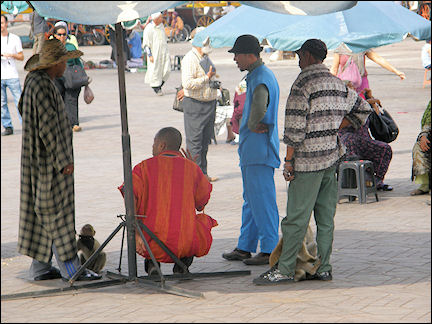
|
Other men sit next to them and beat drums and tambourines, or sit with a snake rolled up like a rope in their hands. You can take pictures of the animals for a fee. The same goes for a few macaques, who are kept on long chains and who try to climb the legs of their owners.
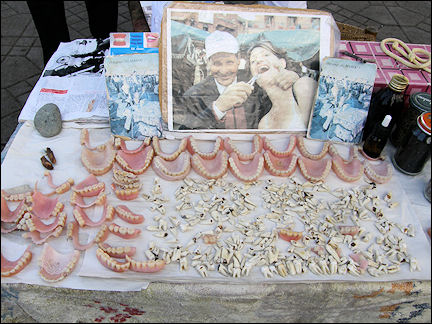
|
Lots of young mothers with babies and old women are begging; they pull you by your sleeves while you're looking at something. A man sits on the pavement, an owl and a falcon, both tied to ropes, in front of him as well as stacks of cards.
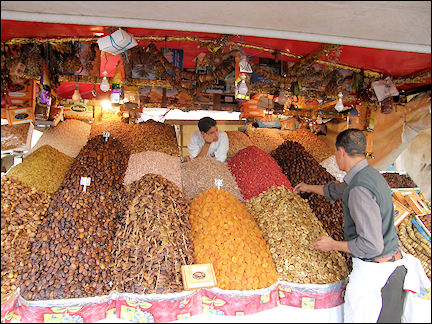
|
A man is standing by a table which is covered with molars and dentures. You can have a tooth mock-pulled and pay to have a picture made of it.
Small boys sell wooden snakes, which they wiggle close to your face. All kinds of souvenirs are scattered on a sheet that lies on the cobblestones.
There are several stalls with stacks of oranges and limes, where you can buy delicious fresh juice for only 3 or 4 dirham. Sinewy men move stacks of boxes and luggage with hand carts. A donkey is parked, anchored by a large bag of rocks that is attached to its cart. The animal stands motionless.
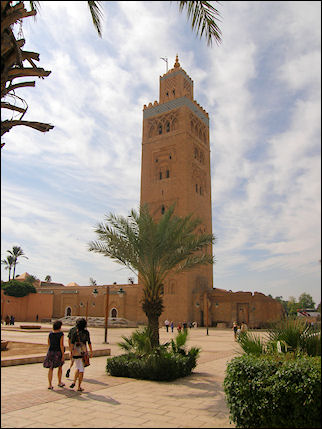
|
Veiled women try to talk female tourists into having their hands and arms decorated with henna patterns. There are stalls with dates, figs and dried apricots.
Men in long red and blue gowns and large hats with tassels and bells walk on the square with drums and rattles and want to be photographed - for a fee.
On the edge of Jemaa el-Fna square, horse-and-wagons are waiting for tourists who don't mind exploring the city in this manner.
We walk around the beautiful Koutoubia mosque. The shape of its impressive minaret reminds me of a lighthouse.
The souks
Brightly colored spices in tall cone shapes
We walk to the souks and are immediately accosted. Looking at something for more than a second apparently means you plan to buy it.
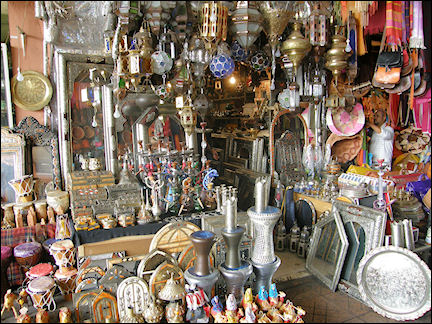
|
There is lot of merchandise: leather bags, metal lamps, cloths, carpets, pointy shoes, wicker baskets, earthenware dishes, phones, packets of tea and brightly colored spices which are displayed in cone shapes in tin boxes.
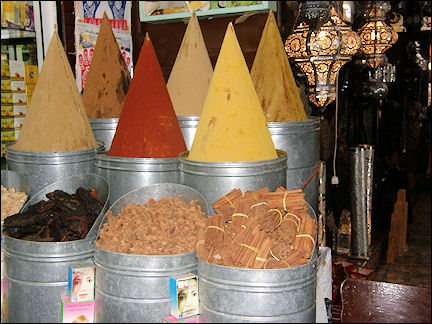
|
There are small barber shops where men get haircuts and shaves. A man with a long black beard, dressed in a bloody white coat, chops up undefinable pieces of meat.
At the entrance of a store is a black cage full of small tortoises. A vendor hawks nice smelling, but ridiculously expensive soap to ladies. The many restaurants all serve mint tea.
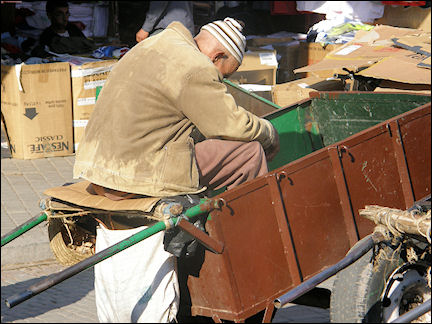
|
We pass through high stone gates on our walk from one alley to the other. Some gates are beautifully carved. In front of the entrance ladies with headscarves sit on low wooden crates. A man is holding four large brown chickens by the legs with both his hands. A neat row of hand carts stands on a square; men are waiting for customers on or by their carts.
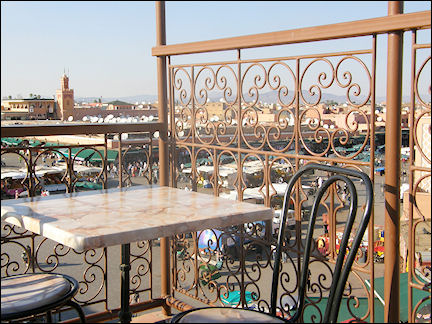
|
A woman in a long grey gown, her face covered by a black cloth, sells coconut cookies. We visit a few travel agents to find out about the cost of a two-day trip to Zagora and finally book the excursion at one of them. A little later we have sodas in one of the outdoor caf&eacture;s with a great view of the square.
Jemaa el-Fna plein at night
Greasy smoke rises from many barbecues
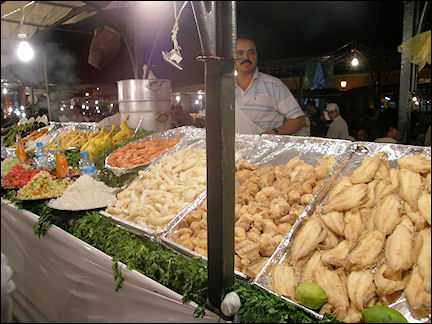
|
At night part of the Jemaa el-Fna square changes into a large open air restaurant. Dozen of stalls, all numbered, are towed into place, including benches and chairs. When it gets dark, bright lights come on.
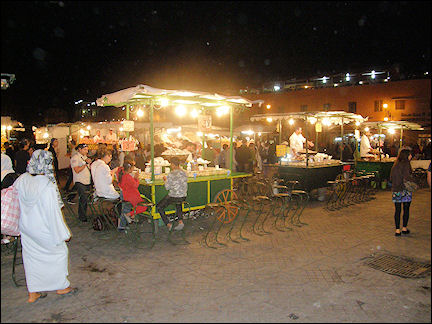
|
Greasy smoke rises from many barbecues. At every stall young men try to lure tourists inside. Whenever they succeed, the new guests are applauded by the staff and taken to their seats.
There are plates with ground meat, lamb, skewers of meat, pieces of squid, shrimp, sardines, chicken legs, couscous, rice, fries, chopped tomatoes and cucumbers, fried fish and all kinds of vegetables.
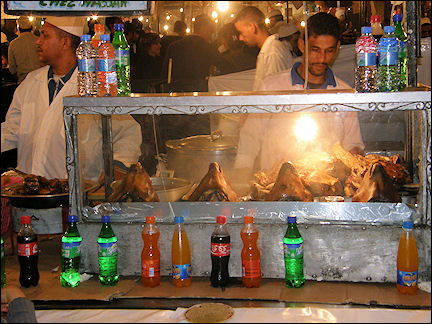
|
Women with babies on their backs sell packs of paper tissues for a few dirham. There are plates with sheep and goat heads, dark-brown and oozing. Water and sodas are served with the meals. The leftovers are grabbed from the tables by small children who eat it while running.
There are stalls that serve boiling hot tea, which smells like spiced cookies. The crumbly cookies that are served with it, taste like the tea smells.
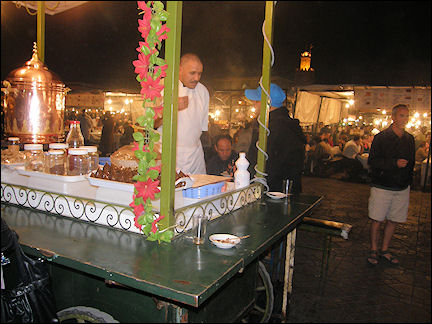
|
On other parts of the square men are singing and dancing. The male audience, seated around the dancers, clap and sing along enthusiastically. An old man takes off his cap and collects money, even though he isn't part of the troupe.
From Marrakech to Zagora
Crossing the Atlas Mountains to the gate of the Sahara
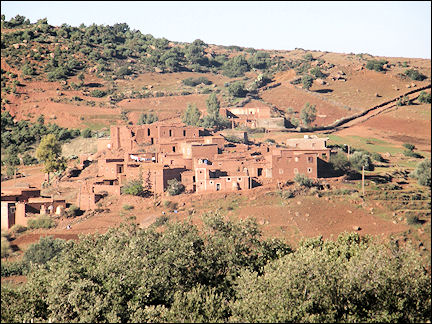
|
A van takes us via Ouarzazate to Zagora, an almost 400 kilometers trip. Near Zagora we will take a camel ride and spend a night in a Bedouin tent in the desert. Our driver is the friendly Abdhou, who is fluent in French, Spanish and English.
We see the Atlas Mountain as grey ghosts in the distance. The landscape around us is dry and flat, the ground is red. Large cactuses grow along the road with purple flowers that look like ripe plumbs stuck to their needles .
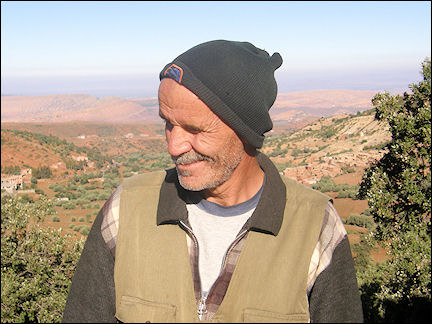
|
Villages with rectangular houses with small square windows hardly stand out, because they have the same color as the surroundings. Every village has a mosque with a terra-cotta colored minaret.
The dark-brown hills are sparsely overgrown with thorny bushes, which look like green sea urchins glued to the slopes. We cross bridges that span wide, dry riverbeds. Here and there a narrow stream splashes over black stones.
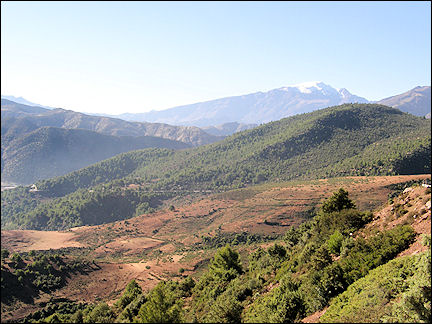
|
It's crowded on the roadside. Heavily loaded, droning trucks creep slowly up a slope. We see old men with weathered faces who calmly ride their trudging donkeys, both legs on one side of their beasts of burden.
Little boys, roaring with laughter, gallop their donkeys as fast as possible. Mother are walking, holding their small children by their hands. Pupils with backpacks walk home from school. Women with large white bags of huge bundles of sticks walk up the steep road with difficulty.
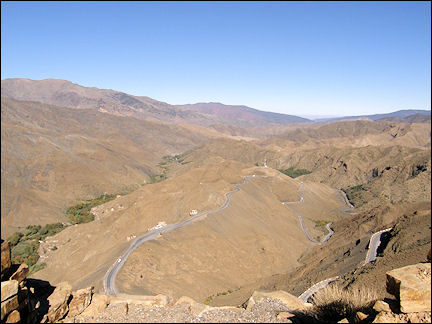
|
There's a cattle market with dozens of grey, white, brown and black donkeys. In several places there are police roadblocks. The arrogant looking cops command respect from the drivers; with short gestures they stop cars and allow them to continue on.
In this part of the country you can buy minerals and fossils. Everywhere there are men with stacks of stones along the road. There are shops with signs that say "Mineraux et fossiles". Large earthenware dishes and glazed tajines are offered as well. The road meanders across the yellow-brown hills, which look rumpled, with snow-covered peaks in the distance.
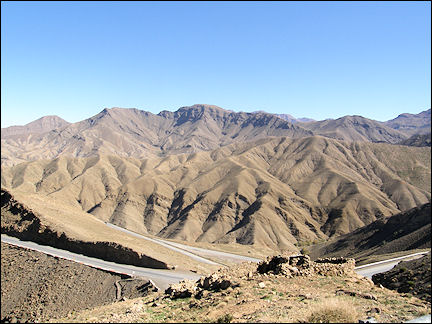
|
There are shepherds with small herds of sheep and goats, which clamber up the arid hills. The mountains get increasingly grey and bare; we are looking at a moonscape. Every now and then the greys are alternated with the fresh-green of fields of mint.
By dromedary to a Bedouin tent
We are followed all the way by long-legged shadows
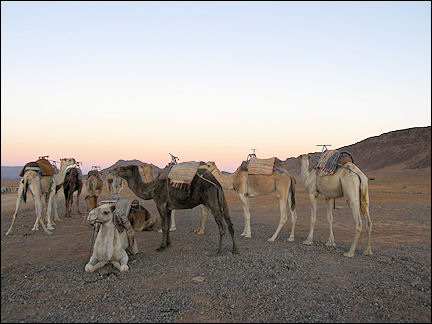
|
We stop on the outskirts of Zagora at a few shops to buy "obligatory" shawls, needed in case of a sandstorm. A little outside the city the dromedaries are ready to take us to our Bedouin tent.
It's already dusk when we leave for an hour long trip. The hoofprints of the dromedaries in the shifting sand look like waterlily leaves. It's pleasantly warm and all but windless when we drudge in silence under a spectacular starry sky. The shawls we bought are fortunately not necessary.
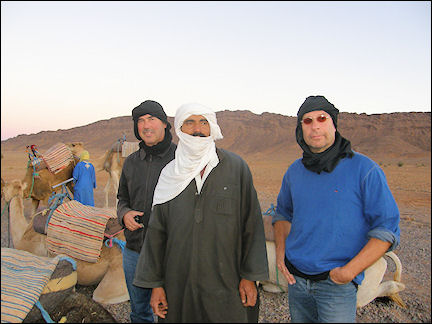
|
Escorts, who lead the animals by ropes, walk in front of the dromedaries. We see the lights of a few tents in the distance. A shooting star completes the fairy-like scene.
Sodas, tea and a meal are served in a large tent. If you want to, you can sit by a campfire afterwards and listen to the clapping, drumming and singing of young Bedouin.
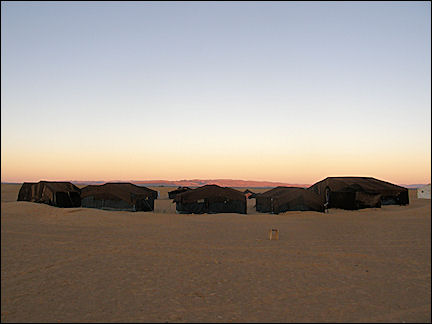
|
The next morning we are woken at 6 AM. Day is breaking and the sun appears over the hill tops, bathing the surrounding hills and mountains in a soft pink glow. Only now we get a good look at our tents in the bare, dry landscape.
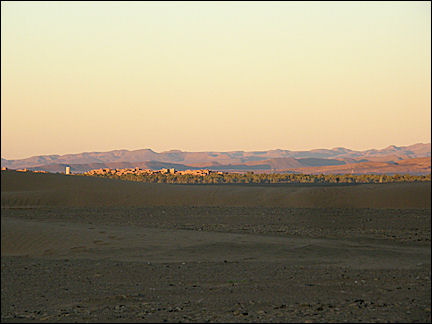
|
Nothing grows here, literally. In the distance we see a small village with sand-colored square houses lighten up in the sun. The dromedaries lie in small groups on the sand. They are exceptional animals, so ugly they're beautiful!
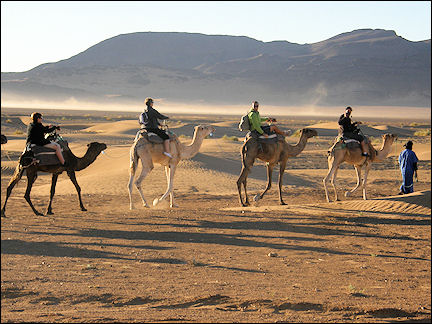
|
Soon the first group of tourists leaves; it's wonderful to see the dromedaries against a backdrop of white shards of morning haze and grey hills.
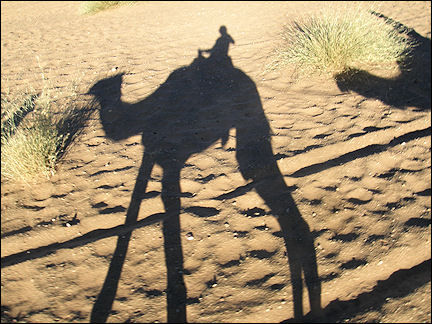
|
After a fine breakfast in the large tent we also leave. During the whole trip we are followed by long-legged shadows. A Berber on a moped appears out of nothing. We are accompanied by several boys. The one who accompanies our group, tries to cadge cigarets, but says "no problem" when it turns out we don't have any to offer.
After a wonderful ride of an hour, under a bright blue sky, we are back at the van. A group of children is waiting for us. They have folded dry leaves into camels and we buy a few.
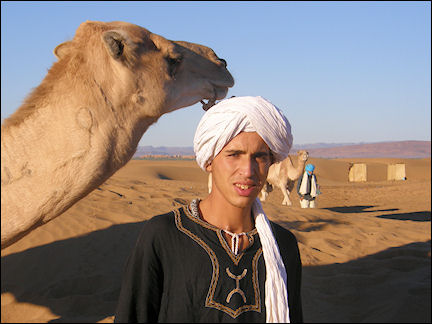
|
We want to hand out cookies from the car, but the pack is grabbed from our hands and some kids make away with it. A little later, Abdhou drives back to Marrakech at high speed.
Aït ben Haddou
Dozens of rectangular brown houses on a hill
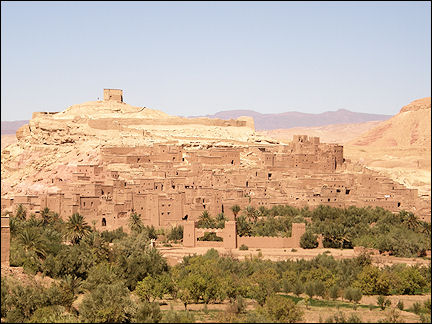
|
We stop on the way to enjoy the view of the kasbah of Aït ben Haddou, which served as a backdrop for the movies Lawrence of Arabia and The Sheltering Sky. Dozens of rectangular, brown houses stand on a hill, huddled together, with windows like gaping holes. On top of a yellow hill stands one lone house, a box of blocks on a molehill.
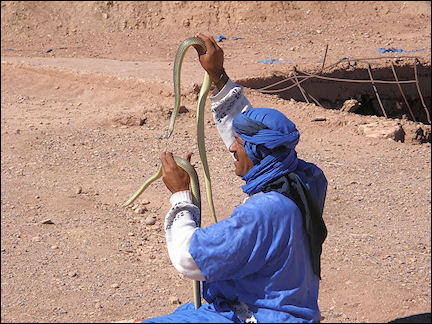
|
On the edge of the city is a green strip with tall palm- and other trees. We stop at a mud house where souvenirs are sold. A man with a blue turban and some snakes in his hand sits in the sand.
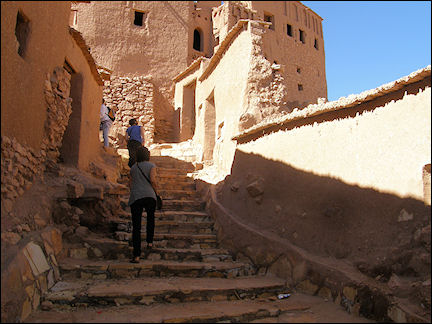
|
We have a meal in a restaurant in a bare street, that looks like one in a Western movie. Then we walk through narrow streets to the back entrance of the kasbah. For a few dirham we cross a shallow river on donkeyback.
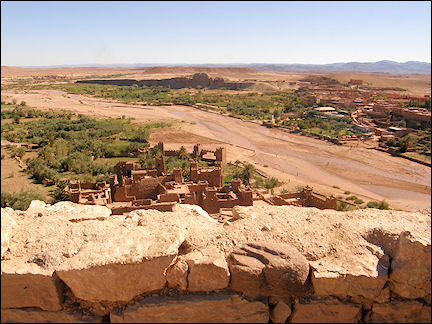
|
We climb up steep stairs, through gates and narrow corridors, and along stores filled with water colors and souvenirs. The views of the city's sand castles below us and the hills and mountains around us are breathtaking.
From Marrakech to Rabat by train
A kid stares curiously at those palefaces
After a night in Marrakech we walk to the nice, modern train station and get tickets to Rabat, our second royal city.

|
At first the landscape is grey and dry, with only every now and then a few small bushes. We see bare hills in the distance. We pass olive groves. White and brown spotted goats are foraging for scarce food on the side of the road. There are groups of trees with tall, thin trunks.
Between and on the hills that are overgrown with dry grass, lie villages with small mud houses. The minarets are without exception bright white. The land is getting flatter and there are large agricultural fields where nothing grows yet. There are soccer fields on the bare sand, with white steel goals.
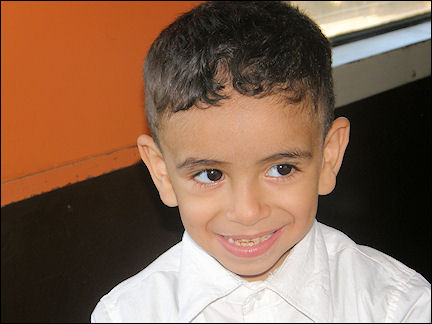
|
The train honks continuously when it passes unattended crossings. Suddenly the flat landscape changes: there are red hills, sparsely overgrown. We see women in long red and green gowns, riding donkeys. A kid from the compartment next to ours keeps coming back to stare curiously at those palefaces.
There are thick palmtrees with ribbed trunks like elephant legs on the platform of the train station in Settat. Many houses in the villages and towns on the way have disks on their roofs. We make a short stop in Casablanca, but the train leaves this city only after a few minutes. Just before we arrive at Gare Rabat Ville, the train station of Rabat, we go through a pitch-dark tunnel.
Rabat
Thousands of tombstones with a view of the Atlantic Ocean
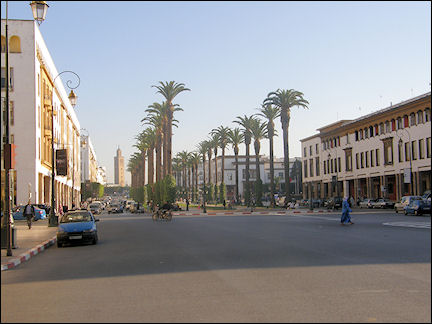
|
Within minutes we find accomodation: a nice but simple hotel near a wide promenade with tall palmtrees on both sides.
We walk the complete length of Avenue Mohammed V. The first part takes us through a newer part of the city. People here are dressed in modern outfits, the stores have a western feel. There are stalls that sell religious books.
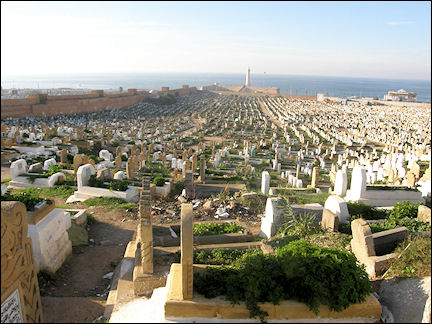
|
The same street also runs through the medina, but here it's a pedestrian area. Lots of stores here, too, but without the pushy salespeople we met in Marrakech. Through a gate at the end of the road we find ourselves suddenly on a huge cemetary, Cimetière Al Shouhada.
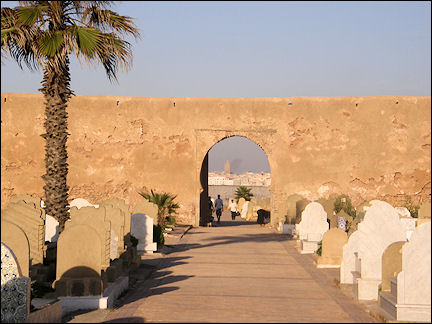
|
The crowds and busyness of the city suddenly seem miles away. Thousands upon thousands of tombstones, all numbered, stand on hills with views of the Atlantic Ocean and the town of Salé. It's so impressive it gives us goosepimples.
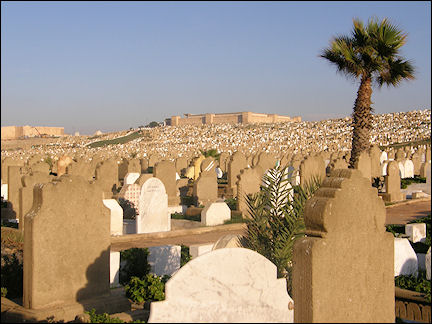
|
On the promenade by the sea we see tough kids with skateboards. People are surfing on the turbulent sea. Couples in love sit hand in hand on a stone wall. We have fresh orange juice in the kasbah. We wander through the alleys with blue and white painted houses and walls.
We see a fantastic, meters high gate from the twelfth century. It's pleasantly calm, despite the large number of tourists. A shoe salesman allows us to take a picture of him.
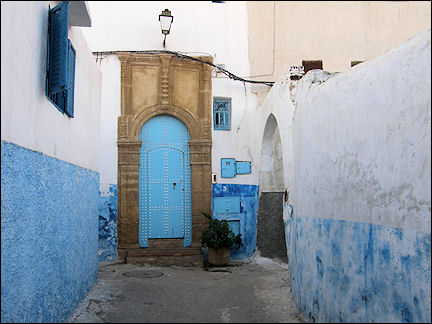
|
We walk back through the busy medina, with dozens of shops that sell clothes, souvenirs, carpets, games, lamps, CDs, DVDs and hookahs. In the middle of the street sits a man who sells small tortoises. An old blind man shuffles with a stick in his hand and beggs for change. People sell cigarets by the piece.
From Rabat to Fès by train
Cactuses are used as fences
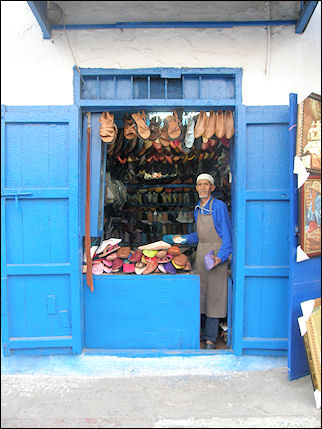
|
In an outdoor café opposite the train station we have coffee and an omelet with baguette. The friendly and skilled waiter wears a dark suit which is several sizes too big for him. An old man walks bent over on te sidewalk. A shoeshiner sits against a tall street lantern and waits for customers.
On the train, a man pushes a cart with paper bags with sandwiches, mugs of coffee and bottles of soda. He taps the metal edge of the cart with his ring to draw attention to his merchandise. All women on the train wear headscarves. The men are almost without exception dressed in shirts underneath sweaters or spencers.
The train takes us through an agricultural area with only a few villages and a single town with low-rising apartment buildings. There are cows and sheep in the fields. Cactuses grow everywhere and are sometimes used as fences.
Smoke rises. A farmer plows his field with two donkeys. Hay is stacked in large half-cylinders, covered with plastic. White herons are startled by the passing train, but continue on their way a little later.
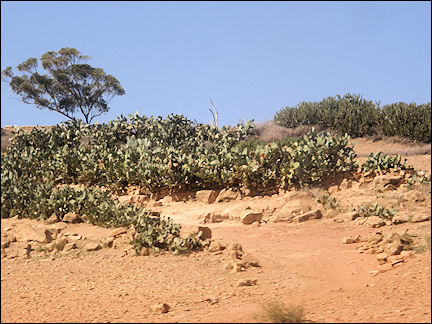
|
Green hills are getting closer. White minarets stand out against the terra-cotta colored houses. Tall agaves grow along a gravelpath. A man with a straw hat beats his donkey forward with a stick. To the left and right of the tracks are vast fields of low grapevines.
At the Meknès train station a brown-spotted dog crosses the tracks, his tail in a cheerful curl. A young man in a baseball cap drives three black-and-white cows over a sandpath. And then we arrive in Fès, our third royal city.
Fès
The medina is a maze of dozens of alleys
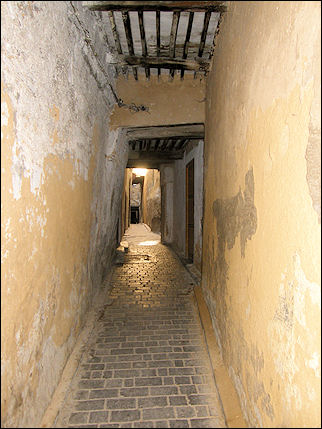
|
We take a taxi from the train station to Place Batha. We soon find a hotel in this neigborhood, at a perfect location. Today the weather is again wonderful. In one of the courtyards of the hotel we enjoy a light meal with an ice-cold Flag Spéciale beer.
After this we explore the medina and are lost within a few minutes in the maze of dozens of alleys. We are followed for quite a while by a young man who keeps offering his services. It is Friday and some stores are closed. The closed shutters offer a dull sight.
Bored men are standing by their carts with fruit. We walk through low alleyways, along beautifully decorated gates and thick doors with ironwork. Large, elegant lamps hang from the walls.
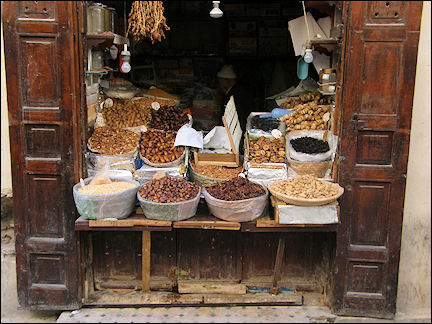
|
The alleys are more or less covered with - meters above us - ceilings of wooden grids, sticks or bamboo mats. There are fountains and taps against tile walls with colorful mosaics.
We apparently look very Dutch, because all around us we hear: "Kijken, kijken, niet kopen!" ("Look, look, don't buy"), "Allemachtig prachtig!" (which is only funny in Dutch, because of the throaty "ch" and just means "amazingly beautiful") and "Kijken is gratis!" ("Looking is free"). All of this refers to the supposed stinginess of the Dutch. Hah hah!
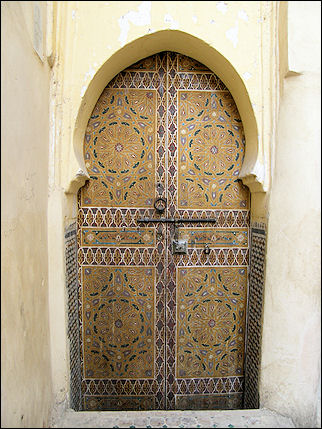
|
On a large square, we have no idea where we are, men and women sit on a low wall, strictly separated. The men are playing cards with wild gestures, the women talk. Children play soccer and other games.
We have dinner in an outdoor restaurant in a busy shopping street, with a view of the constant stream of tourists who pass. We have sodas with our food. Many people are drinking mint tea.
The next morning we leave early to find the tanneries for which Fès is famous. Soon we get near them: we smell a nauseating, pungent odor of ammonia. Donkeys, heavily loaded with hides, are driven through the alleys. You have to get out of their way in order not to be overrun.
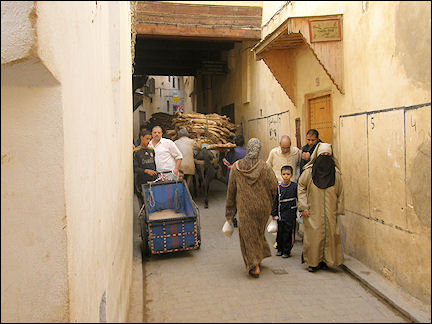
|
We are approached all the time by young men who want to show us the tanneries. We walk through stores with leather bags, coats and pointy shoes to an upper floor where we have a view of groups of men around dye baths with red, white, light- and dark-brown, yellow or grey liquids in them.
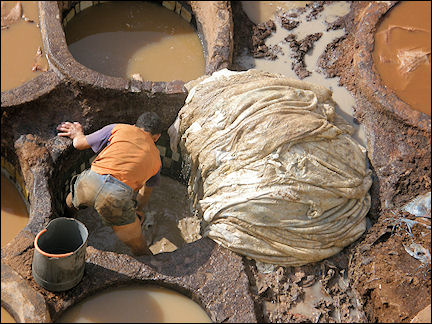
|
Men are standing up to their knees in the stinking ooze and lay hides over the edge of the baths. Spoiled tourists that we are, we get sprigs of mint against the stench, even though we are meters above the toiling workers. Yellow hides are drying on the flat roofs.
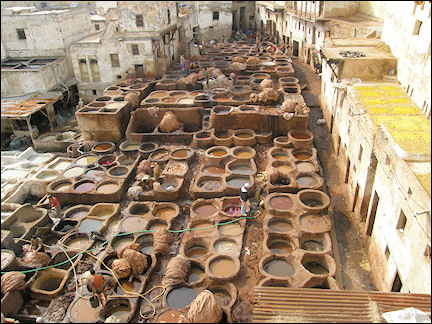
|
Black and brown hides hang from a porch. A continuous stream of dozens of donkeys constantly brings new hides. It's an unforgettable spectacle.
We return to the medina. There's a part with only metal workshops. Skillful craftsmen are beating round metal dishes. Others do the same with pieces of copper.
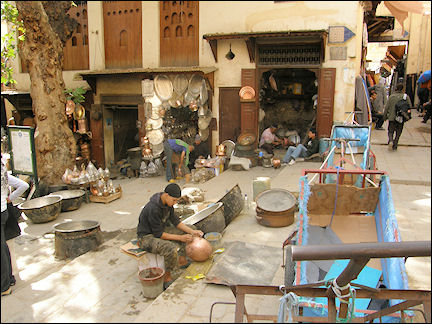
|
Another part of the district is all about leather. And again another has mainly clothing stores. All kinds of merchandise are delivered by donkey to the stores.
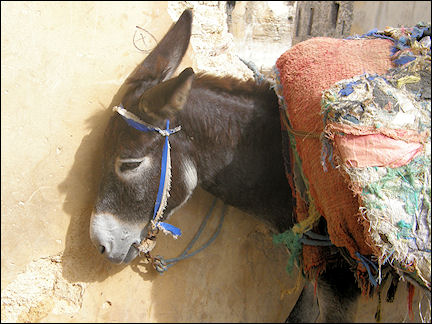
|
A young salesman screams at an old donkey driver, who slinks off with hanging shoulders. There are large, grey metal buckets with spices in many colors. An unwilling mule with gas cannisters tied to his back, drudges by, pulled along by a wrinkled man in sneakers.
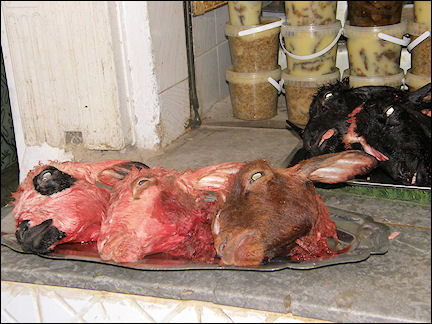
|
There are butcher shops with large chunks of meat, of which you can't even see from which part of which animal they are. A camel head hangs from a hook. A little farther we see a dish with bloody goat heads, their extuinguished eyes turned blue and their tongues hanging out of their mouths.
Beautifully gleaming, proud chickens sit motionless on top of their cages, their feet tied to the bars. White chickens are slaughtered on the spot in a a shop. After their throats are cut, they are placed in a cylinder upside down to bleed out. In fishmonger's shops are containers filled with staring grey sardines and oblong, eel-like fish.
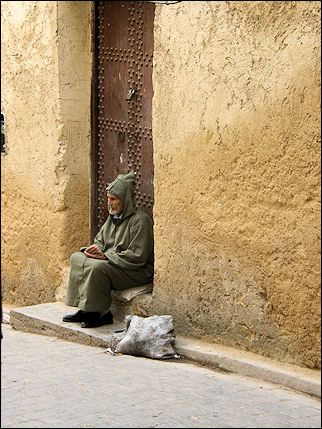
|
We get lost again and arrive at the same spot over and over. Dozens of kids hang out in some of the alleys. There isn't a tourist in sight. An old beggar looks small and frail below a high gate.
We randomly enter alleys, turn a few corners and all of a sudden find ourselves in a busier part of the medina. On a square we stop a small red taxi, which has a square luggage rack on its roof, with on its side written in black letters "Petit taxi". Within minutes we are back at the hotel.
The next morning we take a last look from our window. Then we take our luggage outside and wait for the taxi that will take us to the airport.